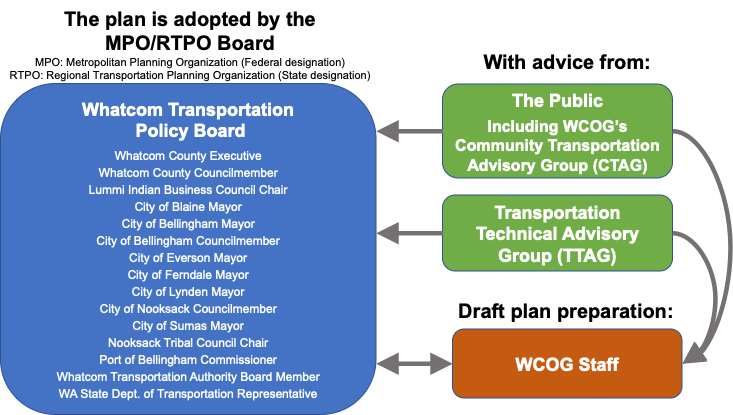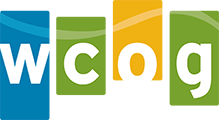1. Introduction
Welcome to Way to Go, Whatcom, the latest update to the Whatcom region’s combined metropolitan and regional transportation plan. This section provides an overview of state and federally required transportation planning and the role that the Whatcom Council of Governments (WCOG) plays in satisfying those requirements.
1.1. What is the Whatcom Council of Governments?
WCOG is a regional planning conference: WCOG was created in 1966 pursuant to RCW 36.64.080, the state law enabling the creation of “regional planning conferences,” more commonly known in Washington as “councils of governments.” In accordance with this legislation, WCOG serves as a regional planning forum for the various jurisdictions in Whatcom County, including the seven cities, Whatcom County government, the Port of Bellingham, the Whatcom Transportation Authority, the Lummi Nation and others. The state’s objective under this legislation is to provide a framework for adjacent and nearby jurisdictions to collaborate on problems that are more effectively addressed as a region.
WCOG is a metropolitan planning organization (MPO): By 1980, the City of Bellingham’s population exceeded 50,000 and accordingly, the federal government designated the City and its environs an “urbanized area.” That designation gave Bellingham access to federal transportation funding, but also required that the federally prescribed transportation planning process be carried out. In order to meet these requirements, Governor John Spellman designated WCOG as the MPO for the Bellingham Urbanized Area in 1982. (Federal law regarding metropolitan planning is found at 23 U.S. Code § 134).
WCOG is a regional transportation planning organization (RTPO): In 1990, following passage of Washington’s Growth Management Act (GMA), WCOG was designated as Whatcom County’s RTPO. (The responsibilities of RTPOs under GMA are contained in RCW 47.80.) As such, WCOG is required to carry out a regional transportation planning process for all of Whatcom County, not just the Bellingham Urbanized Area.
While there are certain differences between the MPO and RTPO planning processes, they are similar enough that WCOG has integrated them into a unified process governed by a combined MPO/RTPO board known as the Whatcom Transportation Policy Board. As a result, Way to Go, Whatcom serves as the long-range transportation plan for all of Whatcom County: its urbanized core in and around Bellingham, its smaller cities, and unincorporated Whatcom County.
Figure 1: Plan Development Flow Chart

1.2. Way to Go, Whatcom: The Long-range Transportation Plan for our Region
While the planning processes that WCOG conducts as an RTPO and MPO are continuous, updates to a long-range (i.e., at least a 20-year horizon) transportation plan are required every five years. Thus, Way to Go, Whatcom 2045 is a snapshot as of 2022: an analysis and discussion of:
- Our region’s goals – the outcomes we expect from our investments in transportation.
- The regional transportation system as it exists and functions today.
- Currently forecasted transportation demand that our region will experience over the next 22 years.
- Our cooperatively developed regional strategy to advance our transportation goals with projects, programs, collaboration, and public engagement – and how to pay for it.
Though Way to Go, Whatcom is now complete, WCOG’s federal and state-mandated transportation planning process continues. System performance monitoring, collaborative identification of needs and solutions, and stakeholder engagement continue to inform policy and investment decisions. WCOG continues to work with and assist its numerous members, particularly by providing technical assistance such as travel demand modeling and project prioritization. And, even with the completion and adoption of Way to Go, Whatcom, WCOG staff will soon begin preparing for the next update of the Whatcom region’s long-range transportation plan in 2027.
1.3. Why does WCOG prepare a regional and metropolitan transportation plan?
A comprehensive, cooperative, and continuing process is required for an urbanized area to be eligible for federal transportation funding. This “3C” process – resulting in this plan – is the mechanism for aligning future investments of public funds with our communities’ priorities, financial capabilities, land-use plans, and population characteristics.
1.3.1. Relationship to sub-regional planning
Whatcom County and its seven cities all engage in transportation planning as part of their GMA-mandated comprehensive planning responsibilities, and the Lummi Nation and Nooksack Tribe carry out similar processes. The Whatcom Transportation Authority – which operates the region’s bus transit and ridesharing services – conducts different capital and long-range planning processes. The Port of Bellingham is also engaged in transportation planning to ensure access to its numerous facilities throughout Whatcom County which include marinas, industrial sites, The Bellingham Transportation Center (cruise terminal, ferry terminal, Amtrak station), and Bellingham International Airport. Through their membership on the Whatcom Transportation Policy Board, these entities’ transportation planning processes inform the regional planning conducted by WCOG, and vice versa.
1.3.2. Relationship to state planning
Metropolitan and regional planning conducted by the MPOs and RTPOs in the State of Washington – including that of WCOG – is integrated with the state’s own transportation planning process, which is the responsibility of the Washington State Department of Transportation (WSDOT). Examples of state plans and processes that WCOG strives to be consistent with include the Highway System Plan, Public Transportation Plan, Freight Plan, Rail Plan, Active Transportation Plan, and others. At the regional level, WSDOT area-office staff and WCOG collaborate on system evaluation and planning through collaborative public process, data collection, and corridor & sub-area studies. The integration of regional and statewide planning is also reflected in WSDOT’s membership on the Whatcom Transportation Policy Board.
1.3.3. Relationship to all of us
Good planning requires the involvement of the public, businesses, non-governmental organizations, and other community groups and constituencies.
The most basic way for anyone to participate in the regional and metropolitan transportation planning process is to attend meetings of the Whatcom Transportation Policy Board and/or share their concerns and ideas directly with the local elected official representing their community on the Policy Board. Forums held in conjunction with proposed transportation initiatives are also good opportunities for people to have their voices heard.
To additionally encourage public involvement in regional planning and project selection, WCOG facilitates the Community Transportation Advisory Group (CTAG). Members of CTAG are private citizens who sign-up to participate in regular meetings and share their perspectives and ideas about transportation.
Citizens can also stay abreast of the work being conducted by WCOG and its member jurisdictions and agencies through their websites (all of which are linked to WCOG’s website, www.wcog.org). WCOG’s plan for citizen involvement is detailed in its Public Participation Plan.
